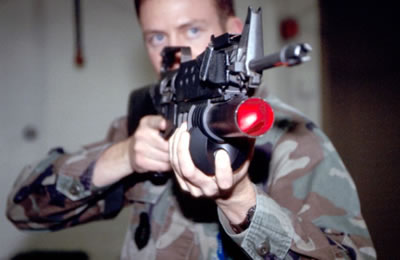Saber 203 laser illuminator temporarily impairs an adversary’s ability to fire a weapon. The laser has an effective range of 300 meters. The operational system uses a semiconductor laser which loads into a modified M-203 40mm grenade launcher. The laser is loaded into the launcher like an actual grenade and is operated by a switch installed below the launcher. In emergency, the capsule can be ejected and replaced with a grenade. The eye-safe laser briefly illuminates an opponent with harmless, low power laser light. On night operations it can be used to degrade human night vision capability and electronic night vision devices. Realizing he has been targeted, the aggressor hides or flees rather than risk death by aiming his weapon and attracting defensive fire.
Advanced 120mm Mortar Munition
Some impressive technological gains have enhanced accuracy, lethality and combat safety for the modern mortar systems.
Projectile guidance technology has already been used since 1994 in 120 mm mortars, with the IR homing Bofors/Saab Strix (picture below left) and the Eastern Block 120 mm Gran (picture at right) mortar rounds. Strix produced by SAAB/Bofors, can engage targets at a range of 7 km, operates in an autonomous heat-seeking mode which can intelligibly recognize targets and discriminate targets among decoys and burning targets. Strix has been in service with the Swedish Army since 1994 and also has been ordered by the Swiss Army. It is optimized as an anti-armor weapon, defeating targets with top-attack.
Cargo munitions are introducing an innovative new advantage for mortars. One of the munitions promoted for use by the AMOS mobile mortar system is a 120 mm cargo munition jointly developed by the Swiss company RUAG and Israel Military Industries (IMI). The M971 mortar bomb carries 32 x M87 dual purpose (anti-personnel/anti-material/armor) submunitions. Each bomblet has can penetrate up to 105mm of steel and releases 1200 preformatted fragments. According to IMI a single cargo round covers a lethality area of 100×100 meters. The bomblets are equipped with dual-action self destruct fuses to minimize hazardous duds. Another cargo bomb is produced By Instalaza of Spain. Mat-120 is equipped with 21 submunitions, each with an electronic impact fuze that also has self-destruct function.
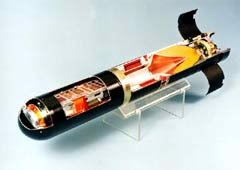 A “semi-smart” mortar munition is under development at Soltam Defense for 120mm tubes. Designated M150/M151 HE-TAG “Mor“, the new design implements laser homing technique for improving the accuracy of the mortar fire against “time-urgent” area targets, rather than hitting point targets at pinpoint accuracy. The idea is to fire a single mortar round on target to neutralize it, thus saving the costly ammunition spent in traditional ranging process. A homing device is fitted to the tip of the bomb, which scans the ground during its terminal trajectory phase searching for the designated target area. Once the laser spot has been acquired, moving tail fins are deployed to correct the bomb’s trajectory to impact on the spot. The M150 has a range of 7,2km, the M151 fired from a longer barrel reaches 9,5km.
A “semi-smart” mortar munition is under development at Soltam Defense for 120mm tubes. Designated M150/M151 HE-TAG “Mor“, the new design implements laser homing technique for improving the accuracy of the mortar fire against “time-urgent” area targets, rather than hitting point targets at pinpoint accuracy. The idea is to fire a single mortar round on target to neutralize it, thus saving the costly ammunition spent in traditional ranging process. A homing device is fitted to the tip of the bomb, which scans the ground during its terminal trajectory phase searching for the designated target area. Once the laser spot has been acquired, moving tail fins are deployed to correct the bomb’s trajectory to impact on the spot. The M150 has a range of 7,2km, the M151 fired from a longer barrel reaches 9,5km.
Additional Parts of this article :
Mortars in Israeli Army Use
Roots of Israel’s Self Propelled mortars
The IDF standard M3A1 Mk-C type mounted a 81mm mortar on a rigid baseplate, which, during the first Arab-Israeli wars became the main tactical support weapon in tank and armoured infantry companies and battalions. Combat proven by insufficient firepower, it was followed by the Mk-D heavy mortar carrier, mounting the Soltam 120mm mortar. Initial firing tests on an AMX-13 chassis failed due to the excessive recoil (120 ton local pressure!) but an ad-hoc quite simple solution produced the answer. Instead of trying to absorb the recoil forces elastically, the Israeli technicians mounted the mortar base to the halftrack mass permanently, thus achieving an overall absorbtion of the recoil blast by the carrier spring mechanism itself. The Mk-D 120mm mobile mortar became a key element in IDF combat support for many years, until more technically advanced systems were locally developed by Soltam.
Additional Parts of this article :
Modern Mobile Mortars Trends
Mobile mortars and their applicationin the modern battle
The enthusiasm in Russian mortars was not matched by the west. Post war Western nations seemed to place limited interest in developing mobile mortar system, placing their priorities on heavier self propelled rocket artillery designs, with nuclear capability. Smaller armies, faced with restricted arms procurement resources such asIsrael’s Army, that had to cope with lack of organic artillery, equippedhalftracks, tank chassis or light armoured vehicles mounting forward firing 81, 120 and 160mm mortars.
AMS II 120mm mortar installed on 8×8 LAV chasis, used by the Royal Saudi Arabian Army.
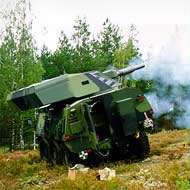
A new trend appeared, however, after Vietnam, as well as the development of low-intensity warfare engagements that followed the Vietnam War, when the lack of organic tactical fire support once again became a major problem to front line troops. One of the main drawbacks, was that man-packed infantry mortars carried insufficient ammunition to provide effective fire support at the tactical combat level and the tactical commander depended mainly on higher unit artillery barrages, which often misfired, due to erratic communications, endangering friendly fire incidents. With ground forces becoming ever more mobile, and AFVs rendering better survivability on a fire saturated battlefield, in-house organic fire support became a vital combat element even at relatively junior tactical levels. This situation became even more critical in Military Operations in Urban Terrain (MOUT) operations, which will become major contingencies in future combat situations. Under such conditions, lack of organic commander’s “hip-pocket” fire support would become devastating for the in-fighting troops.
With dramatic developments in enhanced firepower lethality, under-armor self propelled artillery became a life saving imperative, and battlefield survival of the veteran infantry mortar equally depended on an urgent technological solution. It was in the mid-seventies and early eighties of the last decade, that some of the more interesting developments in mobile mortar design matured into highly effective weapon systems.
Additional Parts of this article :
Laser Induced Plasma Channel
Laser Induced Plasma Channel (LIPC) technology has already been used for a Portal Denial System. The system is designed to be installed as a corridor or passageway denial system that can be employed at either indoor or outdoor locations and can be configured for each individual installation’s security requirement. The system creates a laser guided electric barrier that can be initiated either automatically from an existing customer-supplied computer system that identifies the authorization of the person (similar to conventional keyless entry systems) or via operator command. The system is designed to stop intruders in a passageway or at a vehicle check point, with a lethal or non-lethal electrical discharge.
Modern Mobile Mortars
Mobile mortars application in the modern battle
Often regarded as “poor man’s artillery”, the mortar is returning in a big way to front troops, having been injected by new technology to render enhanced precision firepower.
For generations, mortars have lacked capability to attack “hard” targets, such as armour and fortified bunkers, their main task being the tactical commander’s “hip pocket” weapon for battlefield suppression, illumination and obscuration missions.
These days new mortar systems, using latest state-of-the art technologies, are more versatile, multi-mission and highly lethal firepower, giving the tactical commander highly flexible in-house combat support, to which he so far had no access. While light and medium man-portable mortars are still in vogue, the key element in tactical firepower have become 120mm mortars, which, combined with mobility, protection and advanced “smart” mortar munitions render devastatingly effective and accurate firepower, never attained at such tactical combat level. This article will deal mainly with the new mobile mortar platforms, some of which have already seen action during the latest Operations in Afghanistan and Iraq.
Additional Parts of this article :
Transformation of Air Strike Operations
The transformation of air operations is not focusing only on the aerial dimension, the effects they create, as part of the broader campaign view. For example, as ground forces the shift from heavy to light, rapidly deployable forces such as the Stryker Brigades means that deployed units will require air support more frequently than before and must be ready to respond to such calls in every terrain, including urban environment, which require specialized weaponry and tactics, due to close proximity to friendly and non combatants. To respond to such missions air forces must use smaller, high precision weapons.
The prevailing military thinking has shifted dramatically since the end of the 20th century, when planners focused on the use of Overwhelming Force to ensure victory, (as vindicated in Operation Desert Storm, 1991) to the employment of Overmatching Power, as clearly proven in Operation Iraqi Freedom, 2003. With the efficient use of precision weapons networked employing sensors, intelligence sources and decision making levels throughout the theater, the emphasis has shifted from attrition-based campaign determined by numbers of platforms, to the aggregated effects caused by the weapon used. In this respect, four capabilities are emerging as keys features – Knowledge, Speed, Precision, and Lethality. These elements are currently guiding the transformation of the US forces, and are gradually adapted by many other military forces worldwide.
Information: Intelligence about hostile forces, specifically real-time and near-real time (such as persistent assets such as airborne SAR ground radar surveillance and UAVs and availability of continuous satellite coverage), terrain etc, Blue force situational picture, accurate weather forecasts, technical and logistical information all contribute to an essential resource for planning and efficient utilization of available forces.
Speed: Speed of deployment to the theater, op tempo, speed of processing information and responding to time critical targets. The need for speed has regained the interest in heavy bombers which had lost their popularity since the end of the cold war. They were employed successfully in during Operation Desert Storm, and most impressively, during OEF and OIF, where mass coordinated attacks and pin-point strikes were employed by few B-52H and B-1B bomb loaded “trucks”.
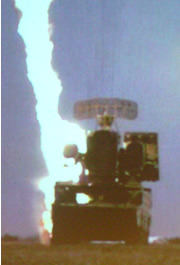 Precision: not just the precision of weapon systems, but also the accuracy of information and targeting. Closing rapid cycles between sensors-and-shooters is a critical factor in the effective employment of precision weapons. This capability frequently requires the employment of special-forces teams on the ground, as well as ground/air liaison and coordination teams. During Desert Storm, about 30 Special Forces teams deployed on missions separate from the conventional force. In OIF, about a thousand men were closely wedded to conventional forces. By being able to carry out “precision decisions” these teams were located where the action unfolded, equipped with target acquisition and designation equipment, using opportunities for the employment of precision weapons.
Precision: not just the precision of weapon systems, but also the accuracy of information and targeting. Closing rapid cycles between sensors-and-shooters is a critical factor in the effective employment of precision weapons. This capability frequently requires the employment of special-forces teams on the ground, as well as ground/air liaison and coordination teams. During Desert Storm, about 30 Special Forces teams deployed on missions separate from the conventional force. In OIF, about a thousand men were closely wedded to conventional forces. By being able to carry out “precision decisions” these teams were located where the action unfolded, equipped with target acquisition and designation equipment, using opportunities for the employment of precision weapons.
Lethality: is directly affected by the timeliness, precision and efficiency of modern weapons. It took an average of four aircraft to kill one target in Desert Storm, whereas in OIF just one aircraft could kill about four targets.
With the introduction of improved knowledge, speed, precision and lethality, the infrastructure and procedures of net centricity operations are also transforming – a critical aspect is planning – which has to be done faster, is also more complex, as human and machine factors must coordinate and are shared across many players, including conventional and special forces. The planning process should also be network centric – not limited to a single aircraft, weapon or unit but must also involve joint forces, and become more responsive to changing scenarios.
Additional parts of this article:
- Precision Strike Weapons
- Precision Strike Concepts
- Transformation of Air Strike Operations
- Net Centric Precision Strike Weapons
- Battle damage Assessment Capabilities
- Precision Strike Systems
- Precision Guidance Concepts
- Modern Bombers Applications for Conventional Warfare
- Precision Attack in Urban Warfare
Modern Mobile Mortars from Russia
Mobile mortars and their applicationin the modern battle
One of the most original 120mm Russian mobile mortar systems, was, and still is, the 120mm 2S9 Nona-S howitzer/mortar system. designed as airborne artillery support vehicle, the Nona is mounted on a modified turret BMD airborne combat vehicle, which can be dropped from tactical transport aircraft. Armed with the 120mm breech-loaded rifled tube 2A60 mortar, it renders both indirect high trajectory and direct point fire capabilities.

Through its semi-automatic loading mechanism, 6-8 rpm firing rate is normal, with 30 seconds action readiness. Another Russian system is the 2S23 120mm SP howitzer/mortar. This model is mounted on a modified BTR-80 platform. In 1996 the Russian Motovilikha Plants Corporation fielded the latest of its Nona family, the 2S31 Vena, an automated self propelled mortar, with a longer barrel, (Russian 120mm 2A80) also firing the Gran laser-guided bomb against point targets to 13km range. The known version was mounted on a BMP-3 chassis and has 70 rounds on board storage (about twice as much as the former). A similar version was developed by the Chinese Army, designated WZ-551 6×6 mounted on an armoured personnel carrier. The Russians seem to love super-big guns, they have designed the mammoth 420mm SP Oka mortar system, which was originally intended to fire tactical nuclear rounds. Fortunately it was never commissioned.
Additional Parts of this article :
Origins of Russian Mobile Mortars
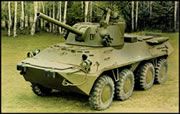
Mobile mortars and their applicationin the modern battle
Development Trends in Russian Mobile Mortars
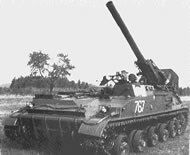
The first serious development in mobile mortar systems came from the Soviet Union, in the immediate post WW2 era. During the war years, the Russinas showed little interest in mobile mortars, in fact, on dedicated SP artillery, the main focus being on ad-hoc anti-armour solutions against the overhelming German panzers. But painful battlefield experience placed self propelled artillery high on the Russian national priority and the results were some interesting solutions, which remain significant technological highlights even today. The traditional smooth-bore barrels mounted on recoil-absorbing baseplates and relatively uncomplicated supports have limited the size, which a mobile platform could support, without collapsing. The German Wehrmacht actually fielded the first mobile mortar, mounting an 8cm infantry mortar on a its SdKfz 250-7 which saw action in Russia in WW2.

First to enter service in the early Sixties, was the huge SM-240 (2S4Tyulpan) mechanised mortar system, mounting a breech-loaded 240mm heavy mortar, firing a power assisted loaded 130kg shell at 1-2 rpm to 12.5km range. The weapon was fired to the rear, the base plate lowered hydraulically from by special device. Another breech loaded mortar, was the Russian 2B9 82mm Vasilyek Automatic Mortar system, which represented a clear break-through in post-war mortar technology. The Vasilyek was recoil operated, munitions fed by four-round clips into the breech, achieving cyclic rate of fire 40-60 rpm in two seconds mounted on a tracked MT-LBu light armoured vehicle. Several derivatives were modified by foreign armies, one of the most interesting, an Iraqi version mounting four rear firing 120mm mortar tubes on a common rear-lowered base.
Additional Parts of this article :
- Modern Mobile Mortars
- Modern Mobile Mortars from Russia
- Origins of Russian Mobile Mortars
- Modern Mobile Mortars Trends
- Mortars in Israeli Army Use
- Advanced 120mm Mortar Munition
- Precision Munitions for 120mm Mortars – US Developments
LIC 2004 – Exhibition Report
The first Low Intensity Conflict exhibition and conference held in Tel Aviv during 22-25 of March, 2004 was an excellent opportunity to learn about the intensive advances in LIC related developments in doctrinal, training technological fields. Facing a prolonged conflict for over three years, the IDF had to transform in combat, from an heavy army based on armored formations, prepared primarily for high intensity conflict to a more flexible infantry oriented force, better trained to for LIC and urban warfare, characterized by net-centric employment of forces at various sizes, from squads to brigades. LIC 2004 provided an exciting first view of many new systems, as well as to the insights of the IDF Ground Forces Command weapons and Doctrine, which, due to the circumstances, became one of the world’s leading authorities on LIC.
Defense Update has covering the event focusing on the following topics:
Magnetic Decoy Mine Activating Devices
 Dedale magnetic decoy device can activate magnetically fused mines at a safe distance from the carrying vehicle. A battery of six Dedale decoys mounted in front of the tank’s maintain a safe arc up to three meters in front of the vehicle. Magnetic signatures are pre-programmed into the Dedale during mission planning, to ensure that the decoy is effective even against the most sophisticated mined. Dedale is also used with other mine clearing systems, including the EBG mine clearing tank.
Dedale magnetic decoy device can activate magnetically fused mines at a safe distance from the carrying vehicle. A battery of six Dedale decoys mounted in front of the tank’s maintain a safe arc up to three meters in front of the vehicle. Magnetic signatures are pre-programmed into the Dedale during mission planning, to ensure that the decoy is effective even against the most sophisticated mined. Dedale is also used with other mine clearing systems, including the EBG mine clearing tank.
Adeve is a lightweight magnetic decoy transmitting a vehicle’s magnetic signature at a distance of four meters ahead and to either side of the vehicle. The system is based on the Demeter system and can be activated or deactivated from the vehicle, and can be used on light vehicles.
DEFEXPO 2004 – Exhibition summary
The DEFEXPO Defense exhibition held early February 2004 at the New Delhi convention center in India, demonstrated an impressive range of weapon systems and technologies originated in India, both from local R&D as well as cooperation with international partners.
Companies participating in this event highlighted systems they expect to promote in the near future for Indian procurement plans. These included the acquisition and modernization of submarines, submarine and surface launch torpedoes and torpedoes countermeasures and submarine launched cruise missiles.
The following topics are covered:




